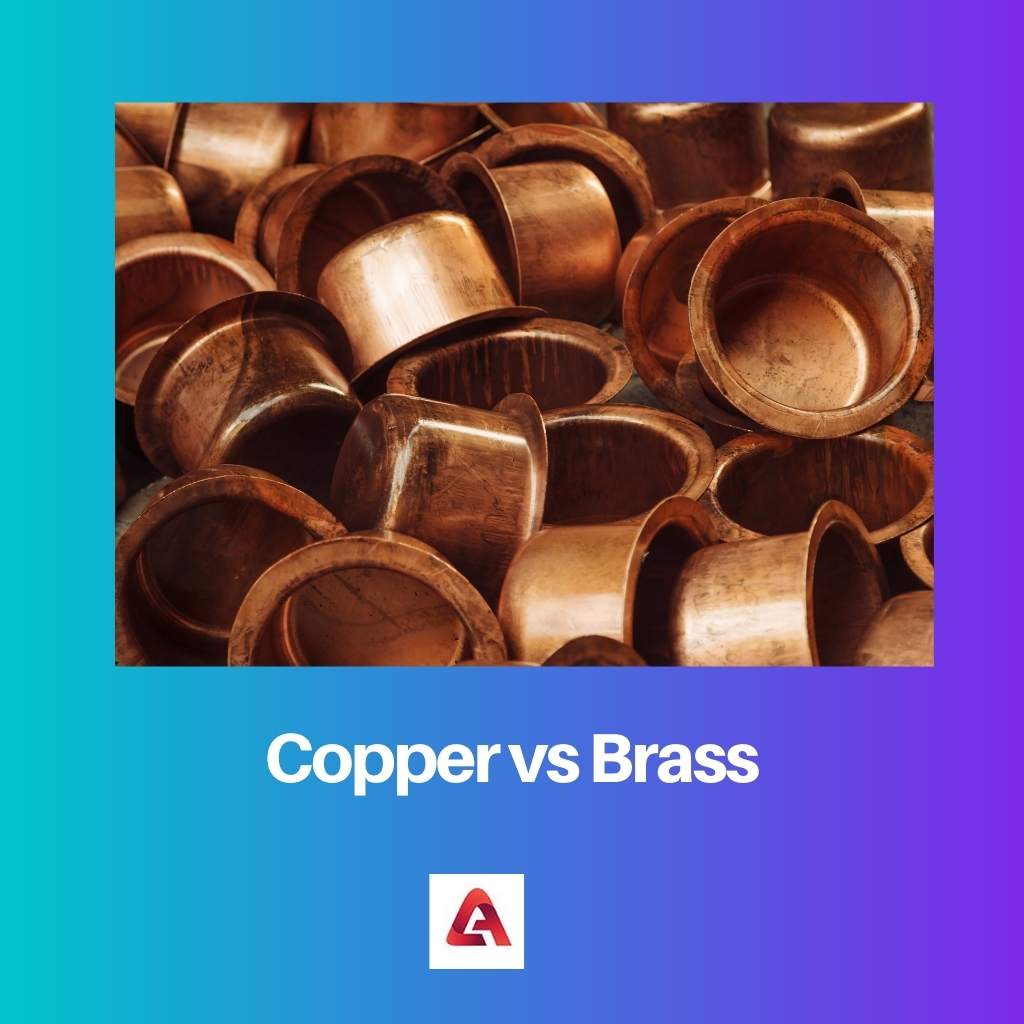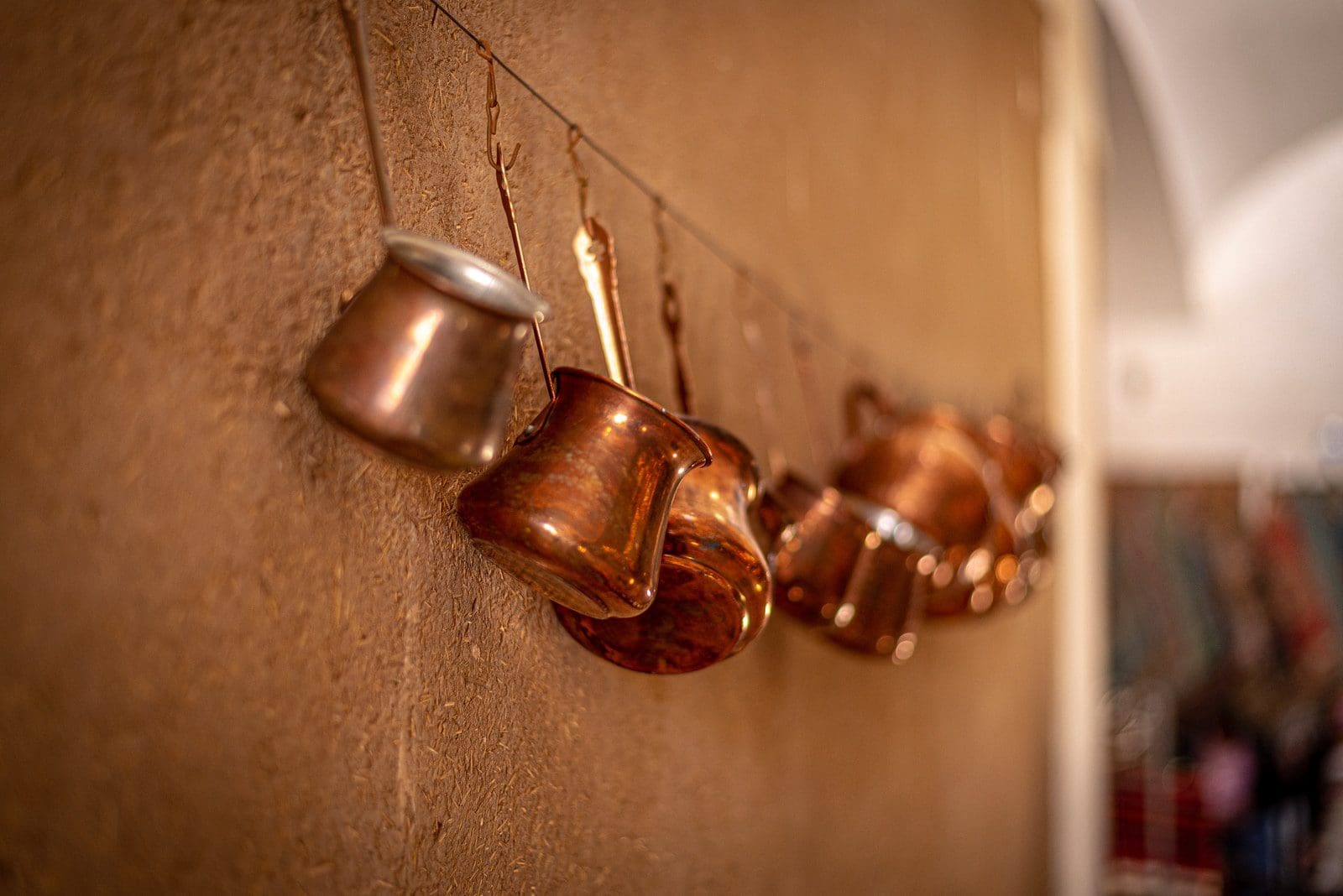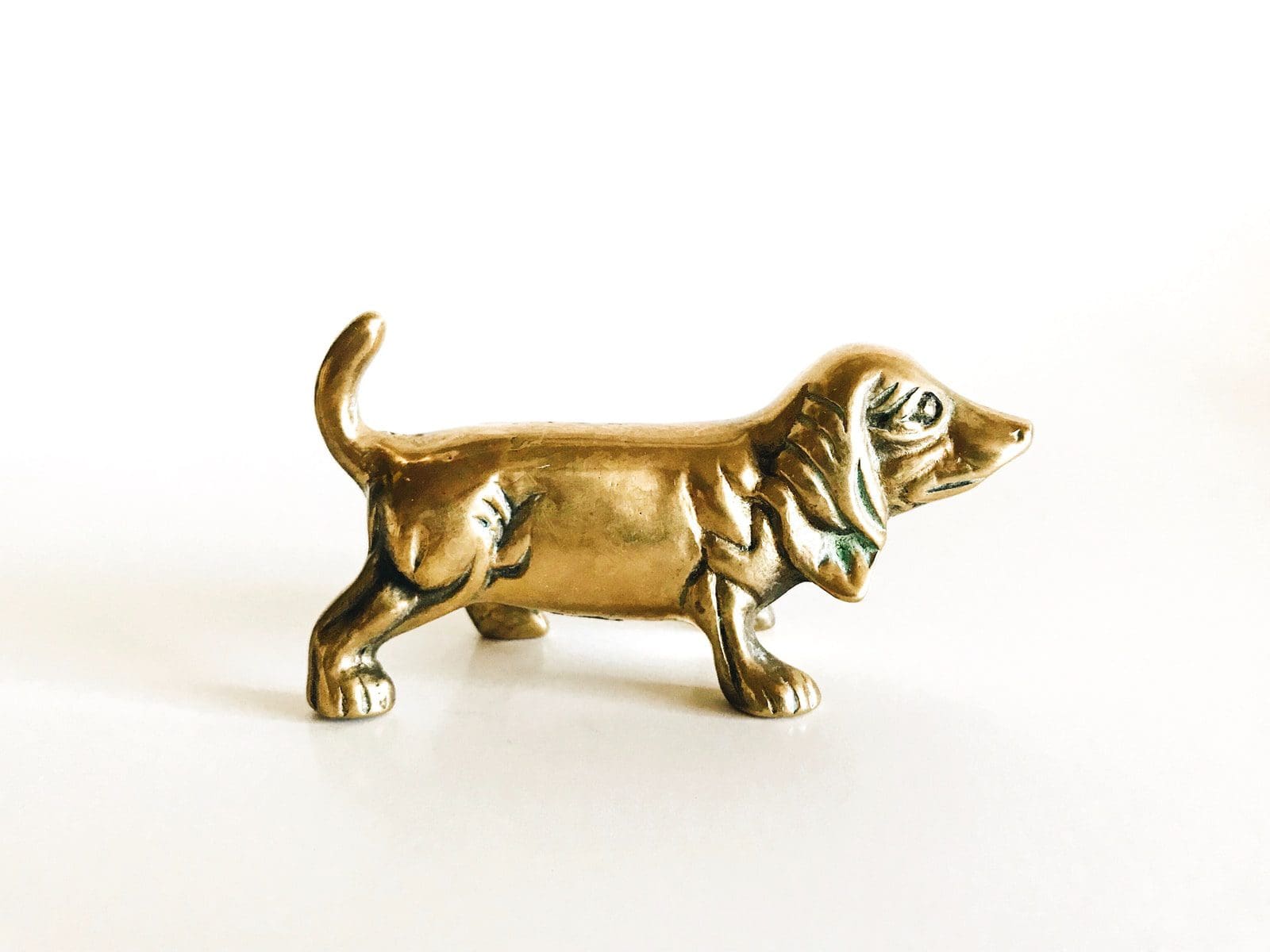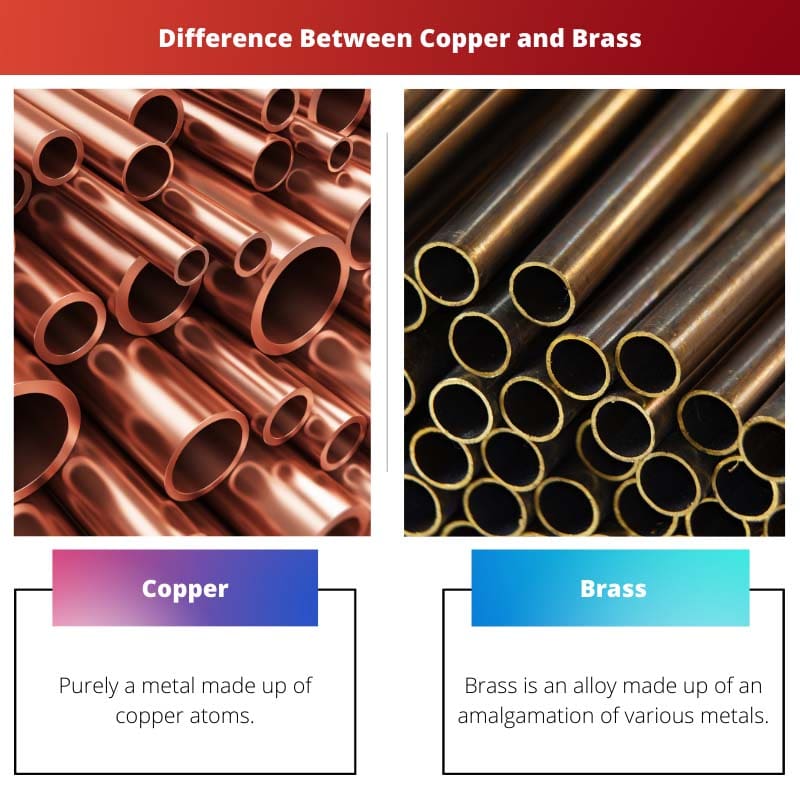Metals are found in abundance and are very essential to man. Generally, they conduct both heat and electricity efficiently. Metals are used in the field of astrology and astrophysics.
Metals can be seen everywhere, like in the construction and manufacture of vehicles, buildings, furniture and other household items such as utensils.
The elements present around us can be categorised as metals, alloys and non-metals. Many people get confused between copper and brass. However, both are used by laymen in various activities. In this article, we will discuss how copper differs from brass.
Key Takeaways
- Copper is a pure metal, while brass is an alloy of copper and zinc.
- Copper has a higher electrical and thermal conductivity than brass, while brass is more malleable and ductile than copper.
- Copper is reddish-brown in color and has a higher melting point than brass, while brass is yellowish-brown in color and has a lower melting point than copper.
Copper vs Brass
Copper, a reddish-brown, ductile metal, excels in electrical conductivity, making it ideal for wiring and electronics. Brass, an alloy of copper and zinc, boasts a golden hue, corrosion resistance, and a lower melting point than copper. This combination makes brass suitable for decorative items, plumbing fittings, and musical instruments, among various other uses.

Copper is pure metal, made up of only copper atoms. This metal is mainly constituted of atoms of copper. There are some impurities present in a micro amount as well. It gives a rustic finish.
This metal appears reddish-brown. The metal is corrosion-resistant. Thus, it does not react with water that easily. The use of copper is extensive in producing and manufacturing sculpture creations, pipe fittings, wires and pipes.
Brass is an alloy. It is an amalgamation and is made up of different metals. Brass is mainly constituted of zinc and copper. However, it also has lead, tin and aluminium present in it. It gives a lighter finish.
This alloy appears bright golden. The alloy shows good resistance towards corrosion in plain water, but in the case of salty water, it reacts. The use of brass is extensive for decorative purposes.
Comparison Table
| Parameters of Comparison | Copper | Brass |
|---|---|---|
| Appearance | Rustic finish. | Lighter finish. |
| Definition | Purely a metal made up of copper atoms. | Brass is an alloy made up of an amalgamation of various metals. |
| Corrosion Resistance | Good corrosion resistance. | Get corroded only in salty water. |
| Composition | Copper atoms, some impurities in micro amount. | Mainly contain zinc, copper: lead, tin, aluminium in less amount. |
| Colour | Reddish-brown | Bright golden coloured. |
| Uses | Manufacture and production of pipe fittings, pipes, sculpture creations, wires, etc. | Decorative purposes use. |
What is Copper?
Copper is metal with a shiny appearance having a reddish-brown colour. It is not made up of any other elements. Thus copper is a pure elemental metal.
This metal possesses quite fewer magnetic properties. When copper is exposed to a very big magnetic field, then it shows a response. This is extensively used in the formation of electrical conductors.
As coppers are one of the best and most efficient conductors of electricity. Copper metal possesses poor strength. Thus, its use is limited in the case of structural applications, as copper can not be broken that easily, as they are not that strong.
The ductility and malleable properties of copper are quite high. Copper can be drawn into thin thread-like structures. Therefore, the use of copper can be seen in the jewellery industry and in electrical applications. It is also a good conductor of heat.
This metal is also used in the manufacture and production of alloys of metals. Copper has a very high degree of resistance towards corrosion. Thus, they are used to manufacture and produce pipe fittings and pipes.

What is Brass?
Brass is an alloy, thus an amalgamation of copper and zinc. However, other elements are also mixed to make Brass apart from copper and zinc. It has good durability and malleability. Brass appears bright golden. Brass has high resistance towards corrosion.
However, brass is corrosive when it reacts with saltwater. Aluminium or zinc is used with zinc and copper in making Brass.
The presence of a high amount of zinc in the brass makes it more ductile and gives good strength—the bright golden colour of brass changes according to the percentage of zinc added to the mixture.
Brass is used extensively for decorative purposes. This is because of its high malleability and good appearance. Brass is a kind of soft metal alloy having good strength. Thus, the brass should be kept at a distance from explosive gases and sparks.
The addition of aluminium in brass makes it corrosion-resistant and improves strength too. Lead is also used in the making of brass for the improvement of mechanical characteristics.

Main Differences Between Copper and Brass
- Copper is purely a metal that is made up of copper atoms only. In contrast, brass is an alloy which is made up of an amalgamation of different metals.
- Copper is mainly composed of atoms of copper and some impurities in micro amounts as well. However, brass is mainly composed of zinc and copper. It also has lead, tin and aluminium added to it.
- Copper gives a rustic finish. In contrast, brass gives a lighter finish.
- Copper appears reddish-brown. On the other hand, brass appears bright golden.
- Copper is corrosion corrosion-resistant and reacts with water easily. However, brass is resistant to corrosion but reacts with salty water.
- Copper’s use is extensive in the manufacture of wires, sculpture creations, pipe fittings and pipes. On the other hand, brass is used for decorative purposes.

- https://link.springer.com/article/10.1007/s00170-007-1241-3
- https://www.tandfonline.com/doi/abs/10.1179/000705980798318708

This article does a great job of breaking down the key differences between copper and brass, especially in terms of their properties and use cases. I appreciate the detailed comparison table which clearly outlines each material’s characteristics.
The information provided here is quite comprehensive. It offers a clear understanding of the distinctions between copper and brass in terms of composition, appearance, and functionality.
I absolutely agree, Harrison. The comparison table is very helpful in understanding the unique qualities of copper and brass.
The article’s explanation of the corrosion resistance of copper and brass is particularly enlightening. It highlights a crucial aspect of these materials and their practical applications.
I completely agree, Jade96. The emphasis on corrosion resistance adds a valuable dimension to our understanding of copper and brass.
The inclusion of practical examples and applications of both copper and brass further enriches the content of this article. It adds a real-world perspective to the information presented.
Absolutely, Gwood. The real-world applications of copper and brass make the article relatable and engaging, shedding light on their wide-ranging uses.
I found the section detailing the characteristics of copper very informative. It effectively explains the properties and uses of copper, making it easy to understand its applications.
I agree, Joanne77. The article does a great job of delving into the specific properties and applications of copper. It’s educational and insightful.
The comprehensive breakdown of copper’s properties and applications is truly enlightening. It provides a deeper understanding of this essential metal.
The thorough examination of the properties and uses of both copper and brass in this article provides a well-rounded understanding of these metals. It’s a highly informative piece.
I couldn’t agree more, Wscott. The article’s detailed analysis offers valuable insights into the unique characteristics and practical applications of copper and brass.
The detailed examination of copper’s electrical conductivity and heat conduction properties offers an insightful perspective on its applications in electrical engineering and related fields.
This article provides a comprehensive analysis of copper’s properties, particularly its electrical conductivity, contributing to a deeper understanding of its role in various industries.
Indeed, Cameron70. The focus on copper’s conductive properties sheds light on its significance in advanced technological and industrial applications.
The comprehensive comparison between copper and brass provides a detailed understanding of their distinct characteristics. It’s an excellent resource for anyone seeking in-depth knowledge about these materials.
I couldn’t agree more, Bellis. The detailed analysis of copper and brass makes this article a valuable reference for anyone interested in metals and alloys.
The detailed comparison table efficiently summarizes the key differences between copper and brass, providing a quick reference to their respective characteristics and uses.
Absolutely, Sophia15. The comparison table simplifies the complexities of copper and brass, offering a convenient snapshot of their unique attributes.
The detailed explanation of brass and its characteristics is quite enlightening. It offers a clear perspective on the unique qualities of brass and its extensive use in decorative applications.
I concur, Walker Eden. The article effectively highlights the key features of brass and its specific utility in various decorative contexts.
The analysis of brass in this article provides valuable insights into the alloy’s composition, strength, and corrosion resistance. It’s a highly informative read.
The detailed descriptions of the properties, appearances, and uses of both copper and brass offer a thorough examination of these materials. It’s a highly educational piece.
I concur, Dkennedy. The depth of information provided in this article offers a comprehensive understanding of copper and brass, making it an excellent resource for readers.
The clarity and depth of information presented in this article make it an invaluable guide to understanding the distinctive features and applications of copper and brass.